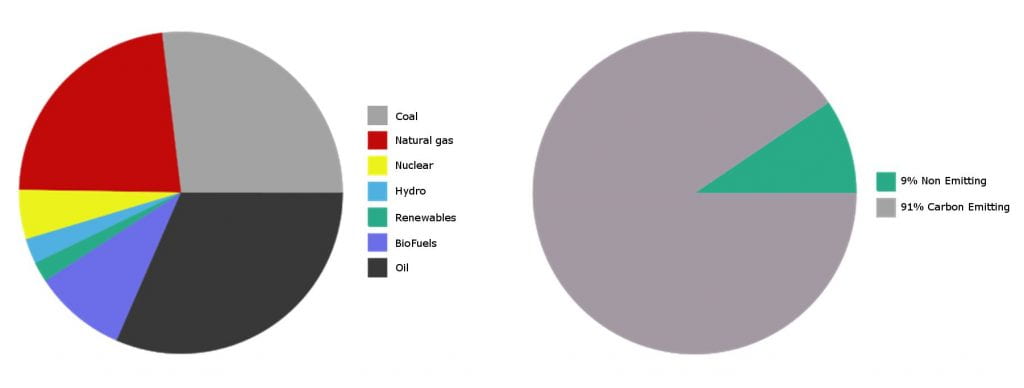Anthropogenic climate change is one of the most pressing issues driving transformational change in the 21st century. In 2015, the United Nations adopted 17 Sustainable Development Goals including Goal 13 which aims to take urgent action to combat climate change and its impacts.
Following this, on Earth Day in 2016, 175 world leaders agreed to reduce emissions by signing the Paris Agreement, marking the achievement as the largest number of countries ever to sign an international agreement on a single day. Some countries have established stronger goals, including Canada and the UK, who are targeting to reach net zero greenhouse gas (GHG) emissions by 2050.
Clean Energy Park Image. Courtesy of ThirdWay, 2017.
The issue of climate change will not be solved in absolute terms. GHG emissions will continue to be a factor impacting international policy and debate, indefinitely.
Permanent problems require permanent solutions.
Today, the world’s energy supply and infrastructure is primarily fossil-based, which has significant advantages over non-emitting energy sources. In addition to being cheap, fossil fuels also provide a perfect response to demand. As soon as heat is needed, fossil fuels can be burnt to meet the demand instantly.
However, to meet the world’s collective climate goals, we need to reduce emissions significantly. We need non-emitting infrastructure. The figures below use data from the International Energy Agency to illustrate the percentage of carbon emitting, and non-emitting energy sources in the global energy supply in 2018.
IEA (2020), Key World Energy Statistics 2020, IEA, Paris
Non-emitting sources accounted for about 9% of the world’s energy mix in 2018, including for applications that are not connected to an electricity grid. The clean energy contribution largely corresponds to hydro and nuclear energy, as renewables such as wind and solar contributed around 1% of the global energy supply in 2018.
In order to combat climate change, our global infrastructure must change, along with our collective mindset, to limit carbon emissions in the world’s energy mix.
A notable risk in changing our energy infrastructure is a loss of flexibility, which is a trick that fossil fuels have mastered. Flexibility refers to the extent to which a power system can modify electricity production or consumption in response to demand variability. Wind and solar cannot operate flexibly as they only produce power when the wind blows and the sun shines. In fact, they are doomed to produce electricity, adding supply to the grid even when it is not needed. Without flexibility, energy and resources are wasted. A solution to this is to store the energy for when it is needed, or use other clean energy sources to meet the difference between the intermittent renewable supply and consumer demand. This is the primary reason why wind and solar alone are not sufficient to power our clean energy future. The world will need a full suite of clean energy solutions.
The COVID-19 pandemic has highlighted the strategic importance of a reliable electricity system to provide uninterrupted energy for hospitals and telecommunication for working within the restrictions imposed by governments. The pandemic also continues to place a unique stress on power demand, which has temporarily decreased by more than 20% in some countries in mid-2020 before rebounding towards trendline levels in late 2020. There will also be lingering impacts on longer-term global energy projects as energy investments are expected to shrink by 20% in 2020.
As we wait to see how COVID-19 will shape our lives, it is clear that cloud storage and software will continue to increase in demand as companies move to decentralize their offices. Shopify – a technology company and the most valuable company in Canada by market capitalization in 2020 – has announced that they would move to a “digital by default” working model where all employees would work from home. Meanwhile, tech giants such as Facebook have initiated programs in preparation for their employees to move out of Silicon Valley. This decentralization of employees will require investments in infrastructure to enable greater bandwidth, secure Virtual Private Networks, and cloud storage through data centres. Already data centres use more than 1% of the global electricity demand. These increases in electricity demand are outpacing increases in low-carbon power, which is causing energy-related CO2 emissions to hit record highs, year after year. Although investment in low carbon technologies has been increasing in recent years, it remains far below the levels that would be required to meet global climate commitments.
This brings us to nuclear energy.
Including nuclear power in the energy mix of our clean future is the only credible pathway for advanced economies to reach the goals outlined in the Paris Agreement, and to reach net zero by 2050. Without nuclear power, the clean energy transition is estimated to cost an extra USD$1.6 trillion, and will increase our risk of failure.
Investment in nuclear energy is a hard sell. New nuclear energy infrastructure projects using existing technologies are very large in scale, and like all megaprojects, tend to run long and over-budget. As the nuclear industry moves towards smaller, modular, nuclear reactors, innovative reactor designs will address these issues, and may mitigate them completely. These Small Modular Reactors (SMRs) are designed with 50 years of lessons learned in nuclear operations. They include inherent safety features, lower costs, cutting-edge manufacturing, and allow penetration into “new” markets for nuclear fission technologies, including off-grid mining and space exploration.
SMRs are being designed to handle the flexibility issue as well. Flexible nuclear power compliments renewable energy sources, as it provides reliable baseload power while enabling real-time changes to power output, allowing the produced power to match the customer demand. Today, nuclear power plants in France operate flexibly to reduce power output in the evening and throughout the night when electricity demand is reduced. Meanwhile, in Canada and the US, the supply of nuclear power is reduced seasonally to respond to increased generation from hydro in the spring. These measures provide stability to electrical grids, including those with high shares of variable renewable sources.
To summarize, climate change is an existential threat and the world will need innovation to transition to our clean energy future. This requires more investment in solar power, wind power, nuclear power, hydropower, hydrogen technologies and batteries; but, more importantly, it means coordinating all of these and strategically deploying them together. With respect to nuclear energy, SMRs are a much needed innovation that can (and will) completely reinvent the industry, and play a key role in realizing our clean energy future.

Brent Wilhelm graduated in 2019 with a Master of Science degree from the University of Guelph, where he also completed his undergraduate degree in physics. Brent now works for the Government of Canada where he analyzes policy related to emerging nuclear energy technologies, including Small Modular Reactors (SMRs).


